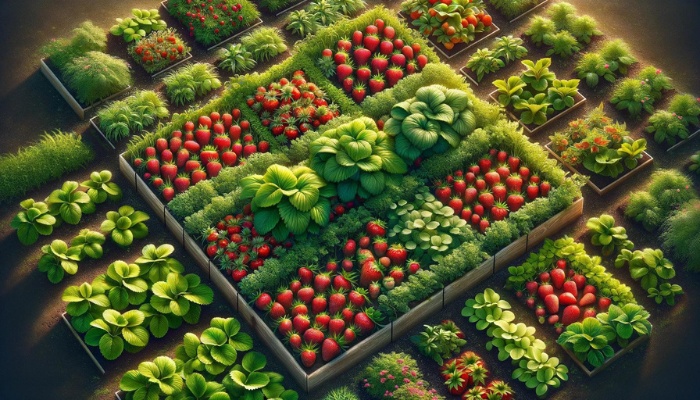Imagine stepping into your garden to find a vibrant patch of red, ripe strawberries waiting to be picked, all within the compact convenience of a square foot garden.
This innovative gardening method, known for maximizing yield in limited space, is a perfect match for strawberry lovers looking to cultivate their own sweet harvest.
We’ll guide you through the journey of planting, caring for, and harvesting strawberries in a square foot garden, ensuring you can enjoy the fruits of your labor with minimal effort and maximum enjoyment.
Get ready to transform your garden into a bountiful strawberry oasis, one square foot at a time.
Understanding Square Foot Gardening
Before getting into the specifics of cultivating strawberries using square foot gardening, it’s important to grasp the fundamentals of this efficient and space-saving agricultural technique.
Square foot gardening capitalizes on dividing your growing area into small square sections, typically 1×1 foot each. This method maximizes yield from a minimal space, making it ideal for those with limited gardening areas.
A key component to success in square foot gardening is understanding soil amendments.
You’ll want to enrich your soil with compost and other organic matter. This step ensures your strawberries have the nutrients they need to thrive.
Proper soil amendments also improve drainage, which is critical for preventing root diseases in your strawberry plants.
Pest control is another vital aspect. In the densely planted confines of a square foot garden, pests can quickly become a problem if not managed effectively.
Incorporating natural predators like ladybugs and barriers such as row covers can help safeguard your strawberries without resorting to harsh chemicals.
Designing Your Strawberry Patch
When designing your strawberry patch using the square foot gardening method, it’s essential to consider plant spacing to ensure each strawberry plant receives ample sunlight and air circulation.
Soil preparation is the foundation of a thriving strawberry patch. Start with a soil test to determine pH levels and nutrient deficiencies.
Strawberries prefer slightly acidic soil, with a pH between 5.5 and 6.8. Amend your soil accordingly with organic matter to improve structure and fertility.
Pest control is integral to protect your strawberries. Utilize companion planting and natural predators to manage pests. For example, planting garlic or onions around your strawberry patch can deter some pests.
Planting and Spacing Strategies

In square foot gardening, determining the optimal spacing for your strawberry plants is critical as it directly impacts their growth, health, and the eventual yield of succulent fruits.
You’ll need to start with thorough soil preparation, ensuring that the soil is rich in organic matter and well-draining. This groundwork fosters a healthy root system, which is vital for robust plant development and fruit production.
When it comes to planting, a general guideline is to space strawberry plants about 12 inches apart within each square foot. T
his spacing allows each plant sufficient room to grow and spread without competing for resources, leading to healthier plants and larger berries. However, you can plant up to four plants in each square foot if you prefer.
In addition to soil preparation, effective pest control is integral to your planting strategy.
By spacing your plants appropriately, you not only promote better air circulation, which reduces the risk of fungal diseases, but you also make it easier to inspect each plant and address pests before they can cause significant damage.
This strategic approach to planting and spacing sets the foundation for a thriving, productive strawberry patch.
Maintenance and Care Tips
First and foremost, pest control is paramount. Regularly inspect your plants for signs of pests such as aphids and spider mites.
Implementing natural predators like ladybugs or using organic insecticidal soaps can be effective in maintaining a healthy crop without resorting to harsh chemicals.
Soil amendments play a significant role in the vitality of your strawberry plants. Strawberries prefer slightly acidic soil with a pH ranging from 5.5 to 6.8.
Testing your soil’s pH annually and adjusting it with sulfur or lime as needed is essential for optimal growth.
Additionally, enriching your soil with organic matter, such as compost or well-rotted manure, will improve soil structure, enhance moisture retention, and provide vital nutrients to your plants.
Ensure you’re watering consistently, aiming for moist but not waterlogged soil, to prevent root rot. Mulching around your plants will help retain moisture, suppress weeds, and keep the fruit clean.
With these maintenance and care tips, you’re well on your way to enjoying a prolific strawberry harvest in your square foot garden.
Harvesting and Enjoying Your Strawberries
The key to harvesting strawberries at their peak involves observing their color, size, and firmness.
Fully ripe strawberries will be bright red and plump and will detach easily from the plant with a gentle tug. Harvest them in the morning when they’re still cool for the best taste.
Once you’ve harvested your strawberries, the enjoyment really begins. Here are some ways to maximize the fruits of your labor:
- Incorporate into strawberry recipes: From classic strawberry shortcakes to refreshing smoothies, the options are endless.
- Immediate consumption: There’s nothing quite like the taste of a fresh, juicy strawberry right out of the garden.
- Preservation: Freeze or make preserves to enjoy your strawberries long after the season ends.
- Sharing: Share your bounty with friends and family.

